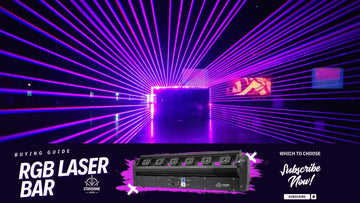RGB Laser Bar vs Moving Head: The Small-Venue Lighting Showdown
If you run a bar, a compact club, or a mobile DJ rig, you’ve probably wrestled with the question: Should I build my look around a laser bar or a moving head? Spoiler: for many small venues, a well-placed B4 RGB Laser Bar delivers huge visual payoff with less setup drama. Let’s skip the fluff and dig into real-world tips.

Visual impact: fan & tunnel vs. spinning shapes
Think of the RGB laser bar as a line painter. Its six laser “eyes” throw razor-clean fan and tunnel beams that read instantly in light haze. Moving heads are shape shifters—gobos, rotations, prisms. On a big stage they’re rock stars; in a 60–120 m² room with low ceilings, that same motion can crowd the space.
 Coverage & installation: linear arrays win small rooms
Coverage & installation: linear arrays win small roomsLaser bars thrive in lines: above the DJ, across a truss, or flanking a booth. Start centered; add a second and third to widen the fan. You’ll hit uniform coverage without juggling pan/tilt limits. Moving heads need height and throw to avoid blasting the audience or the back wall.
Rule of thumb:
- 50–80 m² dance floor → 1–2 bars
- 80–120 m² → 2–3 bars
- Mount 2.2–2.8 m high, 10–20° down-angle, slight outward fan
Control & learning curve
The B4 runs 19-channel DMX with sensible ranges for speed, patterns, and strobe.
- Auto/Sound-active for open hours
- Master-slave for quick multi-unit sync
- DMX for tightened show cues and chases
Maintenance & reliability
Small venues are rough on gear: heat over the booth, dust, and frequent load-ins. A bar with a rugged aluminum housing and smart cooling shrugs it off. Fewer moving assemblies mean fewer 1 a.m. surprises.

Budget & ROI: more effects per dollar
A single B4 RGB Laser Bar pushes six beams with one power run and one DMX address block. Building an equivalent “wall of light” with moving heads means more fixtures, clamps, safeties, cables—and time.
| Criteria | RGB Laser Bar | Moving Head |
|---|---|---|
| Signature look | Fan & tunnel beams, strobe chases | Gobos, rotation, aerial graphics |
| Best room size | 50–120 m² | 100 m²+ or high ceilings |
| Setup speed | Very fast (linear mounting) | Moderate to slow |
| Programming | Easy (19-ch, sound/auto) | Advanced for best results |
| Maintenance | Low (fewer mechanics) | Higher (more moving parts) |
| Cost to coverage | Excellent | Good in larger venues |
Decision checklist
- Room size & ceiling height
- Mounting points: truss, T-bar, booth top
- Desired vibe: clean fans/tunnels vs. rotating patterns
- Weekly programming time you can commit
- Budget for one-and-done vs. scalable array
A tiny bit of tech
The B4 pairs six RGB apertures with a 19-channel map, so you can ride speed, pattern, and strobe without leaving the floor flat. Build a three-unit line and you’ll get:
- Classic fan for warm-up tracks
- Tunnels for peak drops (add light haze)
- Strobe chases for transitions
- Asymmetry flips to keep the crowd visually locked
Safety notes you’ll actually remember
Mount above head height, avoid deliberate audience scanning, and follow local laser safety guidelines. Keep keys and interlocks where they belong—with you.
FAQ
What is an RGB laser bar suitable for small clubs?
A compact bar-style laser that throws crisp fan and tunnel beams. Ideal above a DJ booth or across a short truss for even coverage.
Do I need haze for a laser bar to look good?
Yes — light, even haze helps the beams appear in the air. Avoid heavy fog that turns fans into a flat wall.
How many laser bars do I need for a 50–100 m² room?
Start with 1–2 units centered over the booth. Add a third if your floor is long or you want a deeper tunnel over the crowd.



























